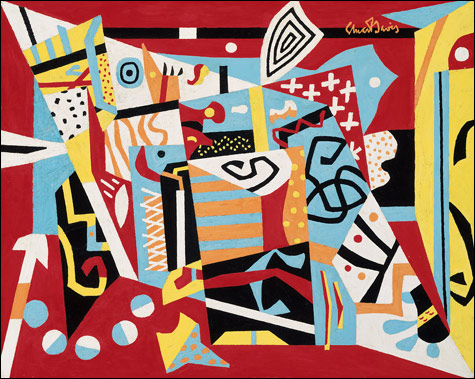
HOT STILL-SCAPE FOR SIX COLORS — 7TH AVENUE STYLE Stuart Davis conveys the abstraction and the feeling of music via art’s own visual language. |
The centerpiece of the Museum of Fine Arts' "Contemporary Outlook: Seeing Songs" is Candice Breitz's 2005 Queen (A Portrait of Madonna), a wall of 30 televisions, each showing a different Madonna fan singing a cappella to her 1990 greatest-hits compilation, The Immaculate Collection. They wear headphones, bob their heads, sing aloud to music we can't hear. They become an angel choir singing "Live To Tell" or "Like a Prayer."It's pretty delicious if, like me, you're a Madonna fan. But I'm not sure how much it's Beitz adding to Madonna's accomplishment and how much it's just that these songs are wired into my heart. Watching the fans sashay, swagger, and cheesily over-emote, you see how the songs are wired into their hearts too. Slick as the music is, it's still a route to some sort of emotional, spiritual ecstasy.
For much of its history, visual art has aimed to spark just this sort of ecstasy, but over the past century, Modernism moved away from this tradition as it broke art down to its atomic elements. Ascetic 1960s and '70s Minimalism and Conceptualism marked the end of the line; they were followed by the ironic detachment of Postmodern visual sampling. The contemporary works in "Seeing Songs" find artists looking to music as they wonder how to reconnect to that deep reservoir of feeling.
It's a fun show, drawn mostly from the MFA's collection by the museum's assistant curator of contemporary art, William Stover. He features three types for work: photos of performers, art inspired by music, and mutations of sheet music.
Among the performer photos: Life magazine photographer Gjon Mili's 1944 shot of Billie Holiday; Bostonian Elsa Dorfman's shots of Bob Dylan singing during his 1975 tour; Herb Ritts photos from the 1980s and '90s of David Bowie, Tina Turner, Bruce Springsteen, Aretha Franklin, and Madonna; Herb Greene's 1960s and '70s shots of Janis Joplin, Grace Slick, Taj Mahal, and the Jefferson Airplane. These photographs are more interesting for who they are than how they are. Ritts's technique looks especially slight in this company. The exception is Richard Avedon's rightly famous trippy 1967 portrait of the Beatles. He electrifies dreamy shots of the lads with a neon-colored, Warhol-esque treatment that channels the Beatles at the peak of their hippiedom.
One room offers dismayingly literal riffs on sheet music, like Idris Khan's prints, which are layered digitally so that they become a gray murk. Better are Wassily Kandinsky's 1910s and '20s attempts to translate music into abstract art, and Stuart Davis's 1940 jitterbugging abstract painting Hot Still-Scape for Six Colors — 7th Avenue Style. Kandinsky and Davis didn't copy musical notation — they sought to convey the abstraction and the feeling of music via art's own visual language.